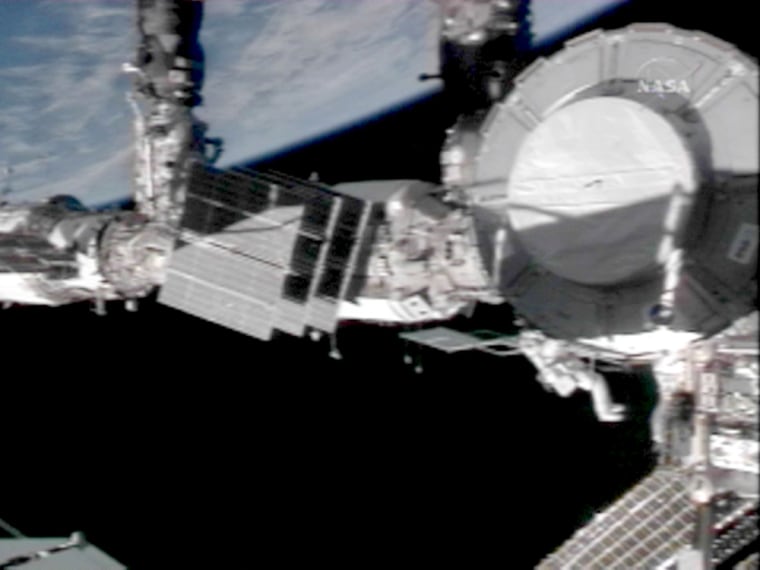Mission managers have cleared Discovery for re-entry November 6th, saying its thermal shielding is in good, solid condition.
It was some good news after a setback discovered by spacewalking astronauts earlier in the day. They found what appeared to be metal shavings inside a joint that is needed to turn a set of solar power panels.
The rotary joint, 10 feet in diameter, has experienced intermittent vibrations and power spikes for nearly two months. Space station managers were hoping a thermal cover or bolt might be hanging up the mechanism, which would have been relatively easy to fix, and were disheartened when Daniel Tani radioed down that metal shavings were everywhere.
“It’s quite clear that it’s metal-to-metal grating or something, and it’s widespread,” Tani said.
“Wow,” said his spacewalking partner, Scott Parazynski.
The shavings resembled small flakes and were clinging to the joint as if to a magnet, Tani said. “It looks like a dusty table that you’d want to dust at home,” he called down.
The astronaut used tape to dab up some of the shavings. It will be returned to Earth aboard Discovery next week for analysis. NASA is uncertain whether the flecks are actually metallic, possibly from the aluminum foil lining the thermal covers, or some other material.
Slideshow 12 photos
Month in Space: January 2014
This rotary joint, launched and installed just four months ago, controls the huge solar panel wings on the right side of the space station, to make sure they’re facing the sun. The joint for the left solar wings is working fine.
The right rotary joint will remain in a parked position as much as possible until the problem is solved, said Mike Suffredini, NASA’s space station program manager. Flight controllers were trying to determine whether any more inspections or even repairs will be needed in the coming week, or whether they can continue to work around the problem following Discovery’s departure.
The astronauts have spare parts for the joint with them in orbit, including extra bearings.
Permanent damage could result
It’s possible that the debris, whatever it is, could cause permanent damage, Suffredini said. Another possibility is that the joint could stall in a position that would diminish solar power. That’s why he intends to move it as little as possible, for now.
It’s too soon to know whether the joint — if it continues to malfunction — will affect science operations aboard the European laboratory that is scheduled to fly to the space station in December, or the Japanese lab that will follow, Suffredini said.
“We have lots of time to work through this problem. It’s not an immediate issue,” Suffredini said at a news conference Sunday afternoon following the spacewalk.
The problem overshadowed the rest of Sunday’s spacewalk, the second of five planned for Discovery’s construction mission.
The spacewalkers’ first job out the hatch was to disconnect bolts and cables holding a 35-foot-long, 35,000-pound girder to the orbiting complex, so astronauts working inside could pull it away with the robot arm. It was the first time the girder and its attached solar power wings were moved since being installed seven years ago, and the job went well.
The girder will be reattached to another spot on the space station Tuesday, and its solar wings unfurled to their full 240 feet across. NASA considers this one of the most difficult construction jobs ever attempted in orbit.
More than six hours of work
During their 6½ hours outside, Tani and Parazynski also added handrails and other equipment to the outside of Harmony, the school-bus-size compartment that was delivered by Discovery and attached to the space station last week. They did not have enough time to finish installing a grappling hook to Harmony, and they had to skip some other work, too.
The rotary joint inspection was added to the spacewalk just a few days ago.
Another last-minute chore involved checking the railroad-like tracks for the space station’s robot arm, to see whether any sharp edges might be protruding. Tani found dozens of micrometeorite dings on a handrail for the tracks but said they did not look particularly sharp.
Spacewalking astronauts have cut their gloves twice on previous missions, and NASA wants to find out where that’s happening.
Meantime, mission managers gave Discovery the go-ahead for re-entry on Nov. 6, saying its thermal shielding is in good, solid condition. It is an eagerly awaited milestone in each mission, based on exhaustive photography and inspections, ever since the destruction of the shuttle Columbia in 2003.

